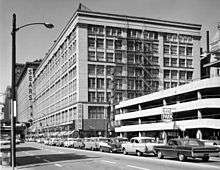William Le Baron Jenney
| William LeBaron Jenney | |
|---|---|
 | |
| Born |
September 25, 1832 Fairhaven, Massachusetts |
| Died | June 15, 1907 (aged 74) |
| Nationality | American |
| Alma mater | École Centrale Paris |
| Occupation | Architect |
| Buildings | Home Insurance Building in Chicago |
| Design | metal-framed skyscraper |


William LeBaron Jenney (September 25, 1832 – June 14, 1907) was an American architect and engineer who is known for building the first skyscraper in 1884 and became known as the Father of the American skyscraper.
In 1998, Jenney was ranked number 89 in the book 1,000 Years, 1,000 People: Ranking the Men and Women Who Shaped the Millennium.
Life and career
Jenney was born in Fairhaven, Massachusetts on September 25, 1832, son of William Proctor Jenney and Eliza LeBaron Gibbs. Jenney began his formal education at Phillips Academy, Andover, in 1846, and at the Lawrence Scientific school at Harvard in 1853, but transferred to l'Ecoides Beaux- Arts in Paris to get an education in engineering and architecture.[1] He graduated in 1856, one year after his classmate, Gustave Eiffel, the designer of the Eiffel Tower. [7] In 1861, he returned to the US to join the Union Army as an engineer in the Civil War, designing fortifications for Generals Sherman and Grant. By the end of the war, he had become a major, and was Engineer-in-Charge at Nashville's Union headquarters.[1] After the war, in 1867, Jenney moved to Chicago, Illinois and began his own architectural office, which specialized in commercial buildings and urban planning.
During the late 1870s, he commuted weekly to Ann Arbor, Michigan to start and teach in the architecture program at the University of Michigan. In later years future leaders of the Chicago School like Louis Sullivan, Daniel Burnham, William Holabird, and Martin Roche, performed their architectural apprenticeships on Jenney's staff.[1] On May 8, 1867, Jenney and Elizabeth "Lizzie" Hannah Cobb, from Cleveland, Ohio were married.[7] They had two children named Max and Francis.[7]
Jenney was elected an Associate of the American Institute of Architects in 1872, and became a Fellow in 1885. He served as first Vice President from 1898 to 1899.[4] In Chicago he designed the Ludington Building and Manhattan building, both built in 1891 and National Historic Landmarks. He also designed the Horticultural Building for the World's Columbian Exposition (1893) held in Chicago.
Legacy
He died in Los Angeles, California, on June 15, 1907. After Jenney's death, his ashes were scattered over his wife's grave, just south of the Eternal Silence section of Uptown's Graceland Cemetery.[5] In 1998, Jenney was ranked number 89 in the book 1,000 Years, 1,000 People: Ranking the Men and Women Who Shaped the Millennium.[7]
Advent of the steel-frame skyscraper
Jenney is best known for designing the ten-story Home Insurance Building in Chicago. The building was the first fully metal-framed building, and is considered the first skyscraper. It was built from 1884 to 1885, enlarged in 1891, and demolished in 1931.[3] In his designs, he used metal columns and beams, instead of stone and brick to support the building's upper levels. The steel needed to support the Home Insurance Building weighed only one-third as much as a ten-story building made of heavy masonry.[3] Using this method, the weight of the building was reduced, thus allowing the possibility to construct even taller structures. Later, he solved the problem of fireproof construction for tall buildings by using masonry, iron, and terra cotta flooring and partitions. In the years from 1889 to 1891, he displayed his system in the construction of the Second Leiter Building, also in Chicago.
According to popular story, one day he came home early and surprised his wife who was reading. She put her book down on top of a bird cage and ran to meet him. He strode across the room, lifted the book and dropped it back on the bird cage two or three times. Then, he exclaimed: "It works! It works! Don’t you see? If this little cage can hold this heavy book, why can’t an iron or steel cage be the framework for a whole building?" Jenney applied his new idea to the construction of the Home Insurance Building, the first skyscraper in the world, which was erected in 1884 at the corner of LaSalle and Monroe Streets in Chicago. The Home Insurance Building was the first example of a steel skeleton building, the first grid of iron columns, girders, beams and floor joists ever constructed.
Projects
.jpg)
- 19 South LaSalle Street, 1893, downtown Chicago
- Col James H. Bowen House, Hyde Park, Chicago, built in 1869
- First Congregational Church, Manistee, Michigan, built in 1892
- Home Insurance Building, Chicago, built in 1884
- Horticultural Building, for the World's Columbian Exposition, Chicago, built in 1893
- Ludington Building, Chicago, built in 1891, National Historic Landmark
- L.Y. Schermerhorn Residence, 124 Scottswood Road, Riverside, Illinois, built in 1869
- Manhattan Building, Chicago, built in 1891, National Historic Landmark
- New York Life Insurance Building, Chicago, built in 1894
- Second Leiter Building, Chicago, built in 1889
- West Park District section of Chicago's boulevard system
- DKE Shant, Ann Arbor, Michigan,1878
References
- ↑ Architecture and Building. XII (1): 5–6. January 4, 1890. Missing or empty
|title=(help)
Notes
- ^ Haden, Erik. "William LeBaron Jenney". Structural Engineers Association of Texas. Archived from the original on May 19, 2005. Retrieved 2005-12-17.
- ^ "Home Insurance Building". PBS Big Building Databank. Retrieved 2005-12-17.
- ^ "Graceland Cemetery". Graveyards of Chicago. Retrieved 2005-12-17.
Further reading
- Turak, Theodore (1986). William Le Baron Jenney: A Pioneer of Modern Architecture (Architecture and Urban Design, No 17). Umi Research Pr. ISBN 0-8357-1734-8.
External links
| Wikimedia Commons has media related to William Le Baron Jenney. |
| Political offices | ||
|---|---|---|
| Preceded by Ebenezer G. D. Holden |
Secretary of State of Michigan 1879–1883 |
Succeeded by Harry A. Conant |